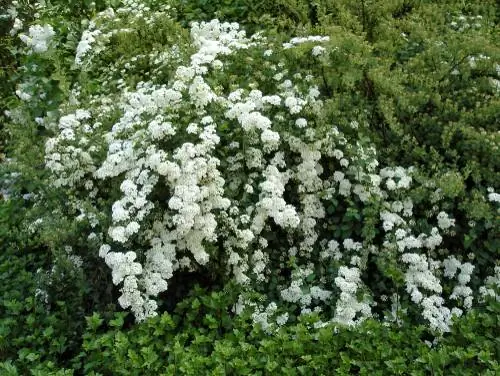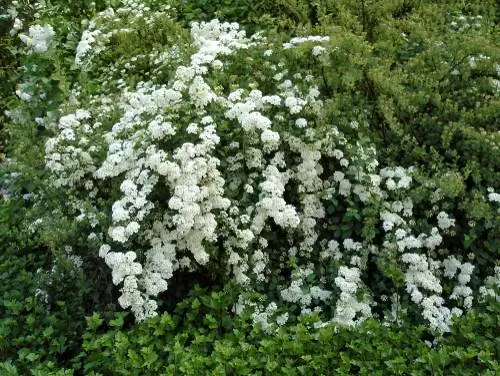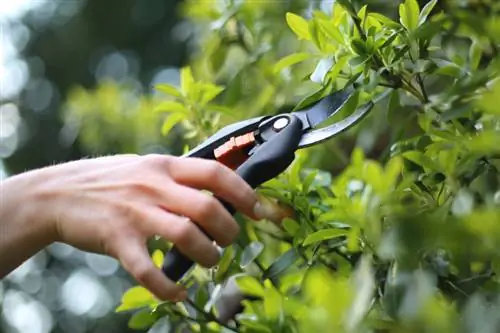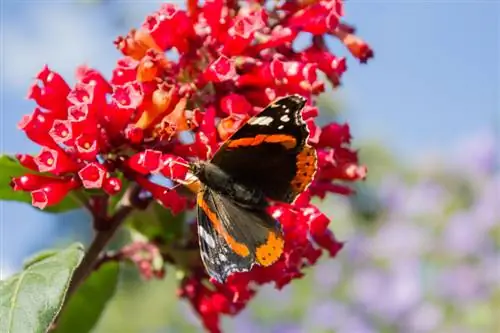- Author admin [email protected].
- Public 2023-12-25 17:45.
- Last modified 2025-01-23 11:22.
From the majestic spring bloomer to the captivatingly fragrant ground cover, the multifaceted genus of spirea shrubs fulfills horticultural design dreams. Are you wondering how to cultivate the hardy, summer-green ornamental tree in your garden? Here you can read all the answers to frequently asked questions.

When and how do you plant and care for a spar bush?
A spar bush is a hardy, summer-green ornamental tree that can be planted from August to October or in spring. Care includes regular watering, fertilizing, pruning, and optional winter protection for the first years of care and potted plants.
Planting spirea shrub correctly
The optimal time window for planting is from August to October. Alternatively, place the spar bush in the thawed ground in spring. While the soil is being meticulously weeded and raked, soak the root ball in water until no more air bubbles appear. Dig a spacious planting pit to enrich the excavation with compost and horn shavings. Then pot up the young spar and plant it in the middle. The previous planting depth should be retained as far as possible. The substrate is solidified with your hands in order to spread out a layer of leaves and water it. Finally, the spar receives a planting cut. To do this, shorten all shoots by half to two thirds.
Care tips
Planted professionally, a spar shrub rarely requires horticultural attention. In order for the opulent abundance of flowers, the dense foliage and the intoxicating scent to develop, the following cultivation is important:
- Water the tree regularly when it is dry
- Following initial fertilization in spring, mulch every 2-3 weeks with compost (€43.00 on Amazon), leaves or grass clippings
- Pamper potted plants with liquid fertilizer from April to August
- Pruning the signs of spring immediately after flowering
- Cut summer bloomers in late winter or early spring
- Winter protection in the planting year and advisable for spars in pots
If you plant a spar bush in spring, an adequate water supply during the summer comes into focus. In contrast to planting in the rainy autumn, during the dry season you cannot avoid a regular visit to your child with a watering can in your hand.read more
Which location is suitable?
One of its outstanding attributes is its flexible attitude towards site conditions. The spar bush thrives splendidly in sunny to partially shaded locations and won't let you down even in light shade. The ornamental tree spreads its roots in any normal garden soil, which can be calcareous. The only thing this gem doesn't want to be bothered with is waterlogging.read more
The correct planting distance
In order to skillfully measure the ideal planting distance, please take a look at the expected growth height and width. Since the genus offers everything from delicate dwarf varieties to mighty flower towers, we have put together recommended distances for popular species for you:
- Splendid spar: 100-150 cm planting distance
- Japanese shrub spar: 50-60 cm planting distance
- Dwarf spar: 30-40 cm planting distance
When measuring the planting distance, please keep in mind that the majority of spirea species thrive almost as wide as they are tall. In addition, numerous trees grow at a rapid rate of up to 50 cm per year, so that apparent gaps are filled within a short time.
When is flowering time?
Cleverly combined, the lavish spirea flowers decorate the garden and balcony from spring to autumn. For your reference, we have listed the flowering times of popular species for you:
- Bridal spars and spring spars: flowering period from April to May
- Splendid spar: flowering period from mid-May to the end of June
- Japanese shrub spar: flowering period from June to July
- Red summer spar: flowering period from July to September
read more
Cutting the spirea bush correctly
Equipped with robust cutting tolerance, you can easily keep the growth of a spar shrub under control with secateurs. The flowering time defines the ideal time. Spring-flowering species should be cut back immediately after flowering, while summer-flowering species should be cut back in late winter. Don't be afraid to shorten shoots that are too long during the growing season. The cutting itself follows this sequence:
- You can optionally shorten the shoots by up to two thirds
- Thoroughly thin out the entire bush
- Cut off shoots that are pointing inwards and rubbing against each other
- Cut fully bloomed branches for vase decorations
Place the scissors 1-2 mm above an outward-facing knot. Such a knot can be recognized as a slight bump under the bark. This cut encourages the plant to branch out happily at this point for a bushy habit.read more
Watering the spirea shrub
Although the spiraea tolerates short-term drought, consistent soil moisture promotes growth and flowering. If the surface of the soil dries out, water the plant in the early morning or late evening. In order not to impair the flowers, overhead irrigation should be avoided. If you are cultivating the wonderfully fragrant flower beauty in a pot, check the moisture content of the substrate every few days using a thumb test. If the top 2-3 cm feel dry, pour directly onto the root disc.
Fertilize the spirea shrub properly
Starting fertilization in March/April gets the growth going. Work some compost with horn shavings into the surface of the soil. Alternatively, a nitrogen-based mineral-organic fertilizer can be used. As a result, the frugal spar bush is grateful for a mulch layer of leaves, grass clippings or compost. For a spar in the bucket, we recommend regular doses of liquid fertilizer from April to August.
Wintering
The spar bush is completely hardy and does not require any precautions for overwintering. We only recommend spreading a layer of leaves on the root disk in the year of planting, as the frost hardiness has not yet fully developed. The following measures make sense for specimens in pots:
- In autumn, cover the planter with bubble wrap, jute or fleece
- Place a block of wood or a styrofoam plate under it
- Cover the substrate with straw, autumn leaves or conifers
Where there is enough space available, a spar in a pot will move to its frost-free winter quarters. Water the plant every now and then to prevent the root ball from drying out completely.
Propagate spirea shrub
The spar shrub seamlessly continues the long list of its convincing advantages in terms of propagation. We have put together tried and tested methods for you here:
- In early summer, pull the sinker to the ground, bury the middle part until an independent root system develops
- Cut head cuttings during the summer and care for them in the pot with a lean substrate
- Cut the cuttings in September, plant them in the ground and let them root
- Sowing the seeds behind glass or directly in the bed
read more
Is spirea poisonous?
The enchanting spirea shrub deserves a special place in every family garden. Since the opulent ornamental tree is not poisonous, it poses no he alth risk. Good-natured and forgiving of many a beginner's mistake, the Spiere is the ideal candidate to awaken the joy of hobby gardening in interested children.read more
Beautiful varieties
- Bridespiere: Fantastically beautiful spring bloomers in bright white and impressive presence; Growth height 150-200 cm
- Triumphans: The bright red cob flowers adorn the tree from June to July; Growth height 150-200 cm
- Anthony Waterer: Stunning summer spar with ruby red umbel flowers until September; Growth height 60-100 cm
- Albiflora: Dainty dwarf spar that covers itself in clouds of white flowers from July to September; Growth height 50-70 cm
- Golden Princess: Wonderful play of colors thanks to pink summer flowers over golden-yellow leaves; Growth height 40-50 cm






